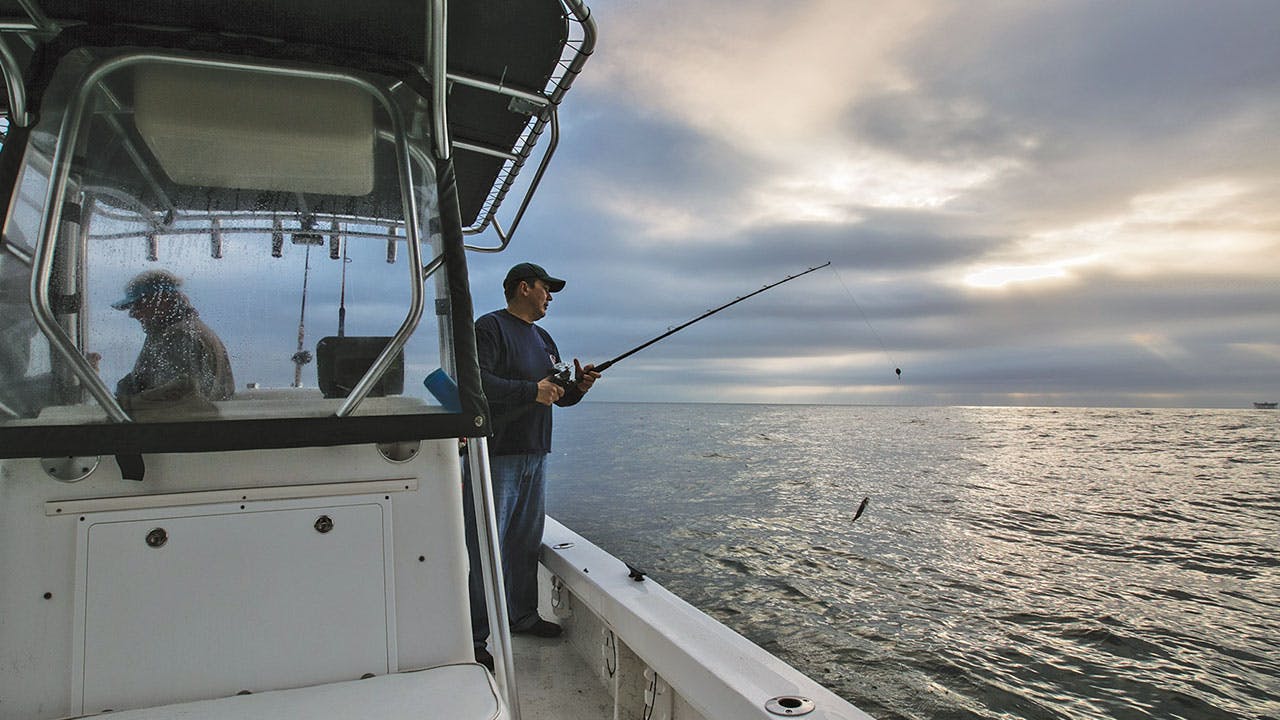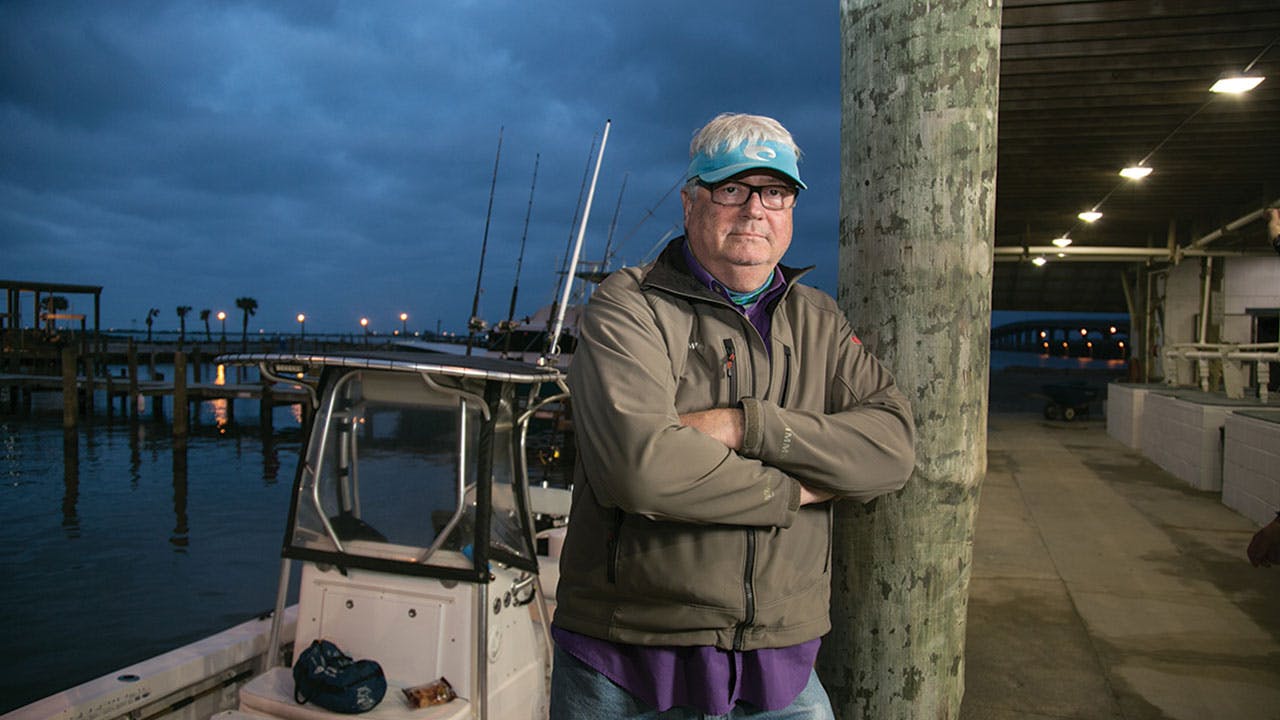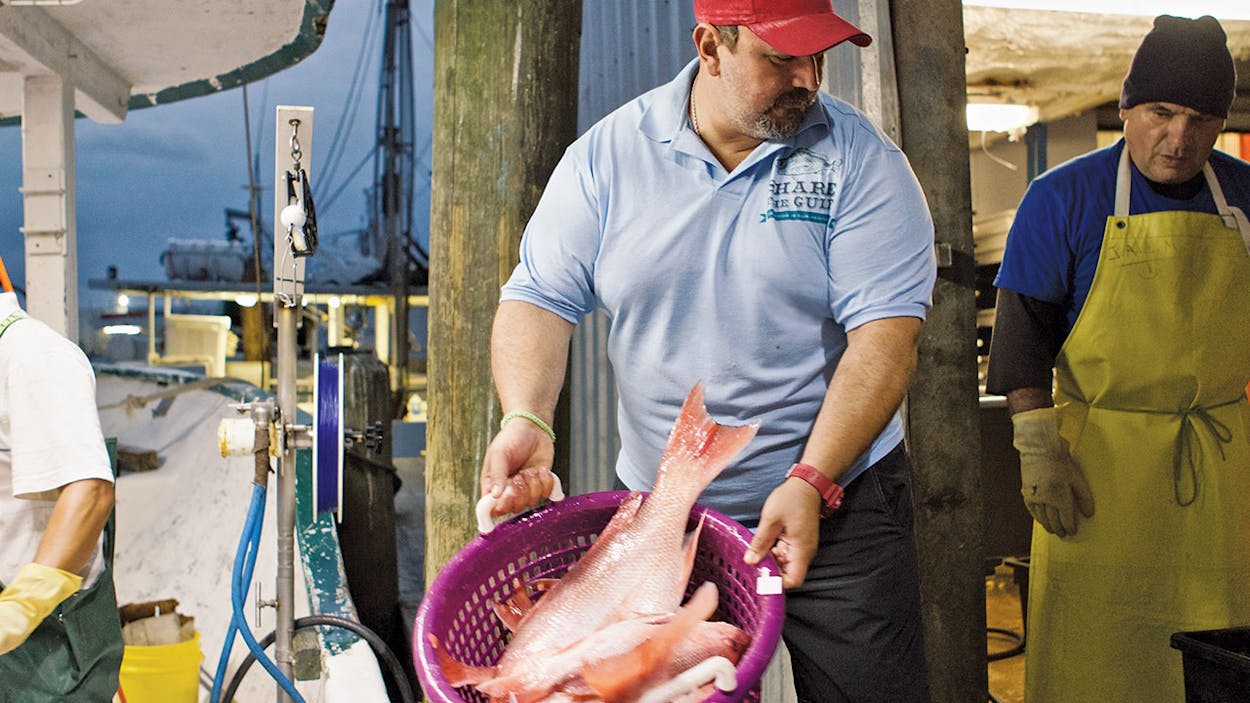Katie’s Seafood Market is a corrugated-metal building on the Galveston waterfront with a wooden ship wheel hanging from its ceiling and an 89-pound snapper mounted near the entrance. A small retail area faces the street, but most of the action happens on the dockside, which opens onto a channel leading to the Gulf of Mexico.
It was there, last November, that William “Bubba” Cochrane could be found supervising the unloading of 11,000 pounds of red snapper from his boat the Chelsea Ann. A beefy man with a gray-flecked beard, Cochrane recorded weights on a clipboard as large blue vats filled with fish. Outside, his twelve-year-old son and deckhand, Conner, moved around the boat in orange bib pants. “Kids in school say, ‘I want to be a video-game designer,’ ” Conner said. “I’m the only one who has ever said, ‘I want to be a fisherman.’ ”
That would have been a ludicrous ambition a decade ago. When Cochrane started fishing for a living in the early nineties, the Gulf population of red snapper—mild and buttery, easy to catch, with pink-orange scales that stand out on market shelves—had bottomed out following a forty-year decline. Potential egg production, a key measure of population health, had fallen to 2.6 percent of its natural level, one tenth of what scientists consider sustainable.
The Gulf of Mexico Fishery Management Council (Gulf Council) and its parent agency, the National Oceanic and Atmospheric Administration (NOAA), scrambled to find solutions. For years commercial fishing was limited to the first ten days of the month during the spring and fall seasons. This led to a mad race—a “derby” in industry parlance—as every vessel barreled into the Gulf at once. “If it was blowing a gale on the first, you had to go,” Cochrane says. “You’ve got bills to pay and a boat loan.”
Under those conditions, fishermen didn’t have time to find the perfect fishing spot. “If I’ve got to kill two hundred pounds of undersized fish to catch fifty pounds of legal fish, I’ll do it,” he says of the attitude during those years. “A few discards, you try not to think about it.”
Derbies didn’t just stress the fishers; they also failed as a conservation tool. Most years, the commercial sector exceeded its allocation. The stock improved, but not by much.
In 2004 the Gulf Council started developing an alternative: applying the tightly regulated system known as individual fishing quotas (IFQs) to the red snapper. A commercial fisherman like Cochrane, based on his historic landings, would be given the right to a certain percentage of the snapper catch; the actual weight would be set annually by the council. He could work year-round until he reached his limit. He would have to notify the government when his vessel headed out and returned home and report how much he caught. When his boat was at sea, the government could monitor its movements electronically.
Despite his unhappiness with the state of Gulf fishing, Cochrane was skeptical. The government had served his industry so poorly that he didn’t trust any plan coming from the feds. Plus, IFQs were being promoted by the Environmental Defense Fund. “Environmentalists,” he says, “were the enemy.” So he voted no in a federally mandated referendum.
“Whoa, boy, was I wrong,” he says now.
Cochrane, it turns out, was in the minority; IFQs passed overwhelmingly and were launched in 2007. Today, Cochrane owns the rights to 2.8 percent of the Gulf’s commercial catch. He received part of that during the initial divvying up of the quota. He then refinanced his home, and his father’s, to purchase more from a retiring fisherman.
It’s a contentious system: snapper shares are now transferable, which means some IFQ holders rent out their quotas and profit off the fish without actually catching them.
Still, Gulf red snapper has rebounded strongly since the IFQs and other conservation measures were introduced. In 2013 the respected Monterey Bay Aquarium Seafood Watch removed the fish from its “avoid” list. More flexibility about when to fish has meant higher prices and more profitability. “Our boats are safer because we have money to invest in them,” says Keith “Buddy” Guindon, the owner of Katie’s and himself a commercial fisherman. Plus, captains can employ year-round deckhands. In the past, Guindon says, ten-day sprints meant hiring temporary labor, and the choices were slim; Guindon preferred heroin addicts over crackheads. “Now you’ve got guys with families, and they’re buying houses and cars,” he says. “They have a stable life because we have a more stable fishery.”
The IFQ system, it turns out, has worked well for most of the region’s commercial fishermen. It’s the Gulf’s thousands of recreational fishermen who are up in arms.

Fishing buddies George Huye and Ben Graham would have rather spent the morning in a boat. But the federal snapper season was closed and, besides, the weather wasn’t cooperating. So we met instead in the Baton Rouge office building where Graham, a commercial real estate broker, works.
Huye is Louisiana state president of the Coastal Conservation Association (CCA), a sportfishing advocacy group formed to combat commercial overfishing. He’s a 62-year-old retired insurance agent, and something of a poet when it comes to describing his pastime.
“There’s something about leaving a dock at daylight and watching the sun come up,” he told me. “Surveying the horizon for storm clouds, and then you start thinking about how blessed you are. And knowing that other people on the boat feel the same way. The camaraderie, the laughter, the spirited joking. The ride home is always special. The sun’s setting on the other horizon, everybody’s popping a beer, the music’s playing loud, and the prayers go out thanking the Lord for providing the day and getting you home safe.”

To them, there’s something pure about tapping into the Gulf’s riches as hobbyists rather than professionals. The commercial fishers, said Graham, a CCA Louisiana state board member, are making money off a public resource.
By federal policy, sportfishers share the snapper catch with the Gulf’s commercial fishers—the recreational share just went from 49 percent to 51.5 percent—though they’re bound by different rules. Recreational anglers don’t have individual quotas. Their haul in federal waters is limited by size restrictions, daily bag limits, and season length, which varies annually. Unlike the commercial fleet, they can fish closer to shore, in waters regulated by state governments, which are much more permissive.
The federal recreational season is based on educated guesswork. There are too many boats and too many docks for NOAA to track, so it can’t close the fishery when a limit is reached. Instead, the agency sets the season using survey data from the previous year. The problem is, nature and human behavior don’t conform to those sorts of projections.
Sportfishers exceeded their collective limit nearly every year, prompting the feds to shrink the season from 75 days in 2009 to 42 in 2013. The states, which are sympathetic to recreational interests, protested by lengthening their own seasons—Texas’s is year-round—which led the feds to scale theirs back further.
The commercial sector worried that these excesses were jeopardizing the red snapper’s comeback. In 2013 Guindon became the lead plaintiff in a lawsuit accusing the federal government of failing to rein in “chronic overharvesting” by recreational anglers. After an eighty-minute hearing, U.S. District Court Judge Barbara Jacobs Rothstein sided with the plaintiffs and ordered NOAA to develop a better plan.
NOAA, working from a new formula, brought the recreational season down even further; this year personal vessels are limited to just nine days in federal waters. These short seasons have made some private anglers extraordinarily resentful, a resentment exacerbated by the fact that many distrust the federal data that govern the season length. Graham says the Gulf of Mexico west of the Mississippi River, where he fishes, teems with snapper. “What bothers me is that we’re out there and we can’t catch them and we can’t keep them and we don’t really know why,” he says.
Scientists say the recovery is not as far along as it might appear from a boat. Red snapper can live more than fifty years, and the Gulf is still dominated by young fish, which are not nearly as fertile as their elders. “Everybody says, ‘Wow, look at all the red snapper,’ ” says Jim Cowan, a fisheries scientist at Louisiana State University. “But red snapper don’t reach their full [breeding] potential until they’re fifteen years old.”
Recreational anglers have fought back against the short seasons by pushing for a larger share of the harvest; CCA recently advocated for 58 percent rather than 51.5 percent, and others have asked for more. They’ve also challenged a new policy that sets aside some of their quota for charter boats.
That leaves the biggest fight of all. Sportfishing groups have backed a measure sponsored by U.S. representative Garret Graves, of Louisiana, that would remove authority over snapper from the federal government and transfer it to a consortium of state fishery managers from across the Gulf. The commercial sector worries that the recreational endgame is to end commercial snapper fishing altogether. CCA’s Louisiana CEO, David Cresson, denies this. His organization, though, has advocated for the states to manage red snapper “based on concepts they have used so successfully on species like red drum and speckled trout.” Those concepts have basically entailed making both species off-limits to the Texas commercial fleet.
“That is the CCA’s mantra: to eliminate commercial fishing,” says Guindon, the Galveston fisherman. “I always engage the CCA guys: Do you want to take that fish away from your grandmother who lives in Idaho? The only way she’s ever going to get a snapper is in a retail market or a restaurant. You’re not bringing it up there to her. You’re going to eat your snappers right at home, you fat bastard. Not caring about your poor grandma.”
Graham isn’t having any of it, noting that snapper—which varies wildly in price—can cost more than steak. “I have an issue when you hear these commercial guys saying, ‘We’re feeding America,’ ” he says. “What common person in America is going to spend $25 a pound on a damn fish? Nobody. It’s complete bullshit.”
Last October, in Washington, a House subcommittee held a combative hearing on whether to shift red-snapper management to the states. Graves, the sponsor, cut off a NOAA official repeatedly and accused the agency of neglecting Gulf Coast wetlands loss and damage from the BP oil spill. “I’m having a little bit of trouble,” he said, “believing that NOAA is out there to be good stewards of the natural resources.”
It’s hard to dispute that the current system has failed sportfishers by shrinking their seasons almost to nothing. Yet all the recreational solutions have been variations on a theme: open the Gulf to everyone, then fiddle with the dials (season length, bag limits) and hope it doesn’t get overfished.
One policy being floated by scientists and policy experts involves holding private anglers personally accountable for each fish they catch. This could be done with stamps or tags, either sold or distributed by lottery. Texas already requires most hunters to attach state-issued tags to the deer they kill and purchase federal “duck stamps” before hunting migratory game birds. Cowan, the fisheries scientist, notes that tags are required to catch some Atlantic bluefin tuna.
This is anathema to many Gulf Coast recreational anglers, because stamps and tags are finite and some people would be excluded. Many sportfishers hold as sacred the idea that everyone with a pleasure boat should be allowed into a fishery. But that principle seems incompatible with a healthy snapper population.
“The boats are getting better. The electronics are getting better. The fishing power just keeps going up,” says Cowan. “Are we just going to give more and more of the allocation to the recreational sector? Or are we going to come up with a viable system where everybody can get what they need but not necessarily all they want?”
There’s no reason, he says, to regard the animals in the water any differently than we regard the animals on land. “We just need to start thinking about fish more like we think about wildlife.”
This article was produced with the Food and Environment Reporting Network, a nonprofit investigative news organization.







